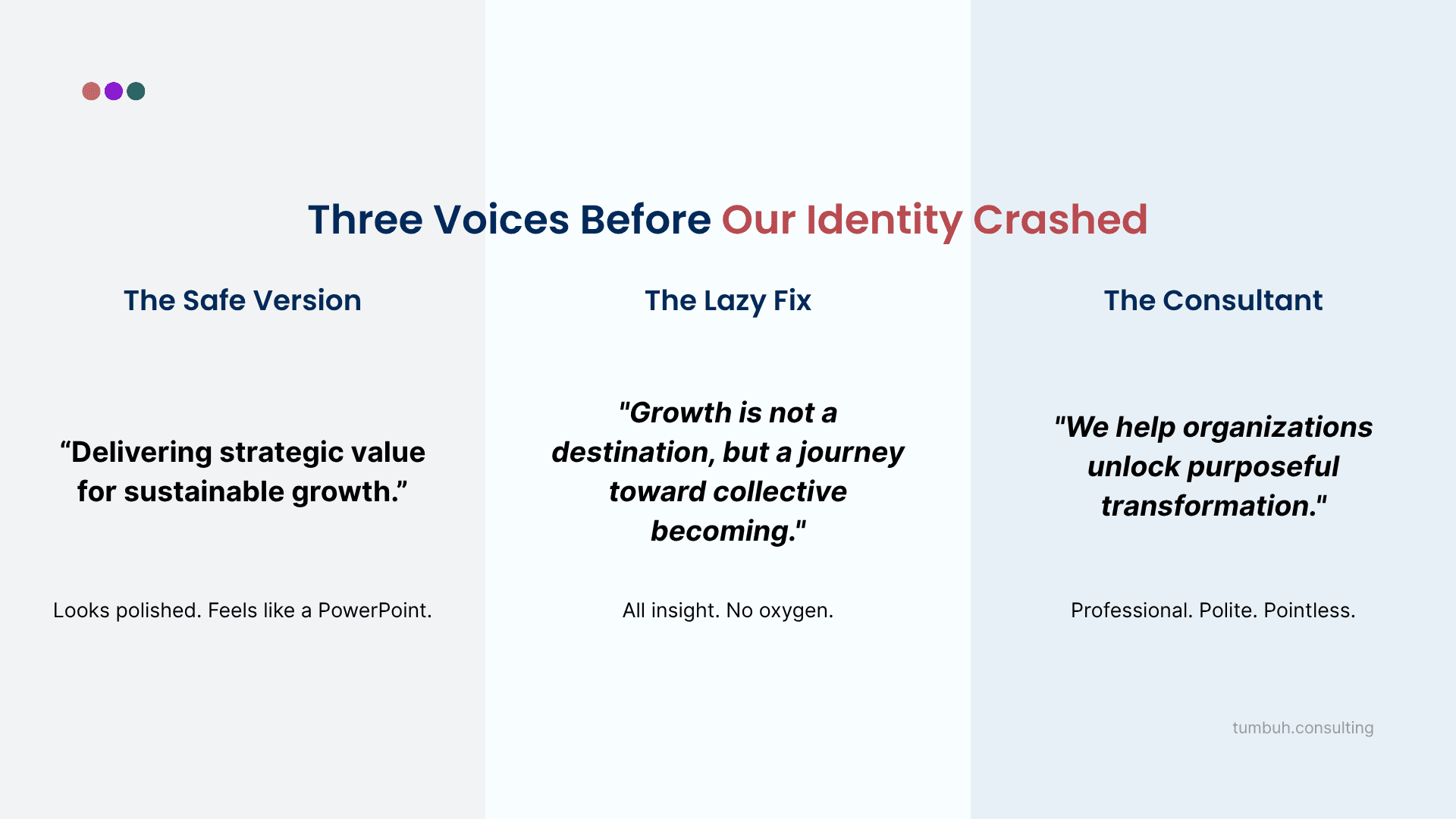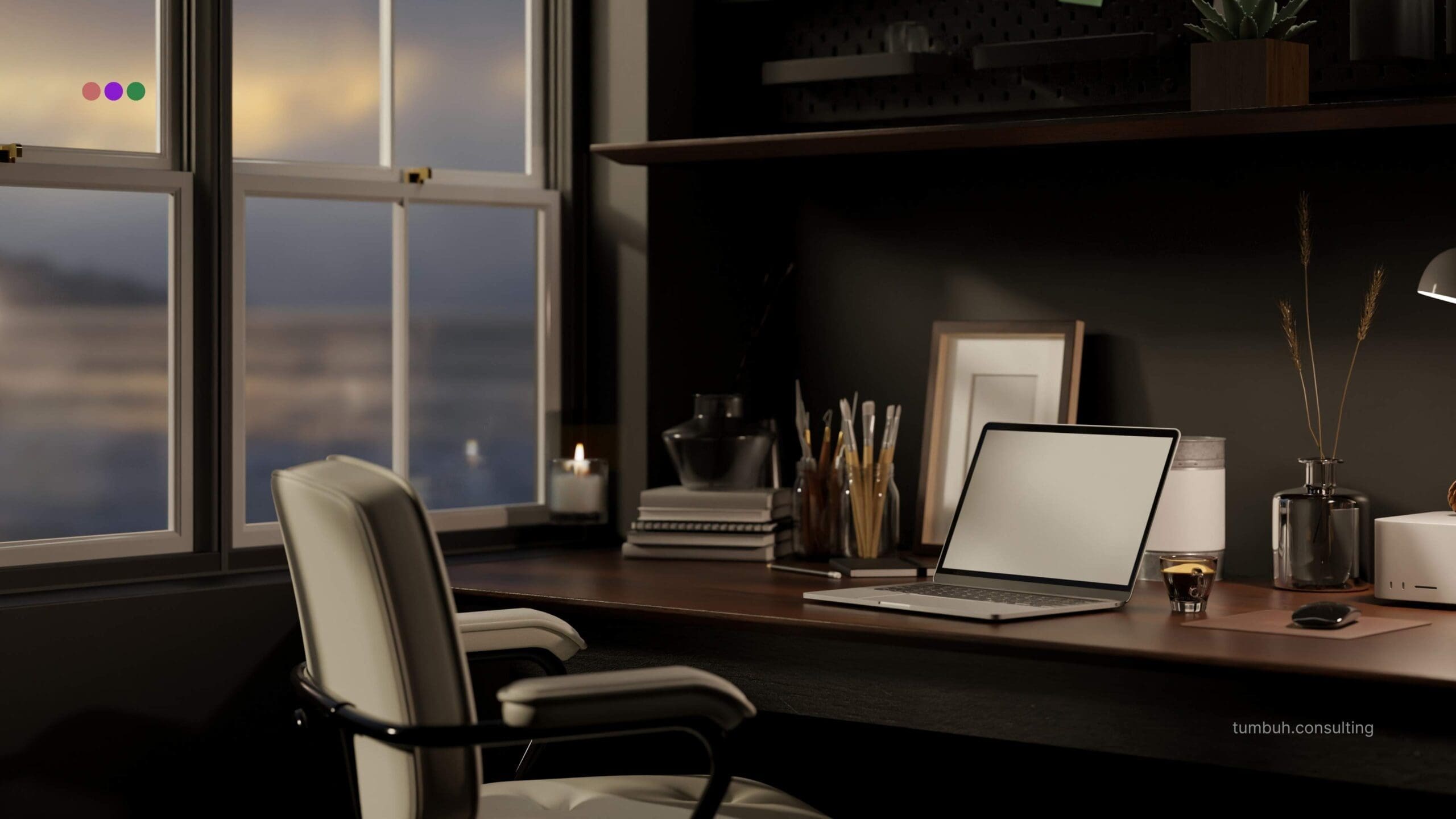When Words Stopped Working
We thought the hard part was over. After the colors found their calm and the logo stopped changing its mind, things finally went quiet — that kind of quiet that feels earned. For about six minutes. Like the calm before the storm.
That's when the copywriters walked in and said,
"We heard the visuals are done. We don't want to ruin the joy, but… we haven't done the voice part. So…?”
The room went silent again, but in a different way this time — the kind of silence that means we're about to question everything we just celebrated. Because how do you design honesty if you can't say it?
Design, at least, gives you something to look at. Shapes behave. Colors blend. Lines align eventually. But words? Words have opinions. They echo. They argue. They don't just show who you are — they test if you mean it.
That's what this part of the rebrand became: not about pixels or palettes anymore, but about finding a voice that didn't sound like an echo of everyone else's. We thought we were rewriting sentences. Turns out, we were rewriting ourselves.
The Versions Before the Voice
After the copywriters walked in, we did what tired teams always do — we convinced ourselves it was almost done. The visuals were finished, the logo was finally behaving, and the website looked alive again. All that was left was the voice. How hard could that be?
So we opened what we already had — the old copy — and decided to "just optimize it." Maybe tweak a few sentences, add a touch of our new philosophy, and call it a day. After all, the most important thing in (re)brand(ing) is the visual, right? Apparently, we were wrong.

Three tones, zero truth.
The Safe Version
What we found was the usual corporate comfort tone — confident, polished, and politely lifeless. It was the kind of copy that looks great on pitch decks but dies in conversation. You know the lines:
"Delivering strategic value for sustainable growth."
"Helping businesses accelerate their digital transformation journey."
"Your trusted partner in innovation."
It wasn't bad. It was just safe — so safe it could've been anyone's. The kind of writing that, when we did it on a Friday afternoon, somehow made the whole room (or at least our mood) feel like Sunday night.
That was our "before." It looked mature, but it didn't mean much.
The Lazy Fix
Our first instinct was to elevate it — to sprinkle a bit of "depth" across the old bones, make it sound smarter, warmer, more meaningful. We started weaving our ideas about growth, purpose, and change into the same corporate skeleton, hoping they'd come to life.
At first glance, it felt profound. Until we read it again:
"Growth is not a destination, but a continuous journey toward collective becoming."
"Every action we take ripples outward into something greater."
It was all insight, no oxygen — pretty words strung together like a workshop exercise. We sounded like a brand that had just discovered philosophy and wanted everyone to know. Literally.
The worst part? For a few hours, we believed it worked. Then we realized we hadn't found our voice — we'd just taught the old one how to meditate. It works, the meditation. Not the copy.
The Consultant Version
Then came the rewrites — the shared docs, the comments, the long chats that started with "quick question" and ended three hours later with a new existential crisis. We overcorrected: tired of sounding poetic, we decided to sound "professional." After all, we're a consulting company.
This version was everything a consulting firm's copy should be — crisp, balanced, and completely neutral.
"We help organizations unlock purposeful transformation."
"Turning strategic insight into sustainable impact."
"Partnering with leaders to design meaningful change."
Nobody hated it — which, in hindsight, should've been our first warning. The "Your Highness" kind of sentences that barely touch grass. They passed the grammar check but failed the vibe check.
But at the time, we were proud. It sounded sure, structured, and finally "ready." After weeks of rewriting, we'd found something we could agree on — or at least, stop fighting about.
So we launched with it.
The Reveal
For a moment, it felt perfect. The logo gleamed. The colors hummed. The visuals carried the weight of everything we'd built. But within a day, a quiet unease began to creep in. Poppins and Inter looked like they were smiling, but the copy had stolen their childhood.
Something didn't click. The brand looked alive; the words still sounded rehearsed. They were confident, but not curious. Honest, but not human.
It was good — too good, maybe. And good, we learned, can still feel wrong. We had a brand that finally looked like us. But somehow, it still didn't sound like us.
So, we started over after the launch, epic.
Keep the Reflection Going
The Growth Circle is our letter for leaders and teams shaping growth cultures — one reflection from the field, one practical framework, or one question worth exploring with your team. Practical, human, and worth your time.
The Growth Circle
Shared when it's ready. Always worth your time.
When We Stopped Sounding Like a Company
Two days after the launch, the silence came back — not the proud kind from before, but the awkward kind that happens when everyone's avoiding the same elephant in the room. The visuals looked stunning; the words looked… fine. And fine, as we'd learned, is just failure wearing a photo filter.
We'd said all the right things, but somehow they didn't sound true. It was as if we'd written a version of ourselves that existed only on presentation slides — a company that spoke perfectly and yet didn't sound like anyone in the room.
So we did what no one wants to do right after a launch: we reopened the documents. The same ones we'd "promised" not to touch for at least a week.
"At TUMBUH, we empower growth through clarity, helping teams turn vision into measurable progress."
"Our purpose is to unlock potential through collaboration, insight, and action."
It looked perfect — capital-P professional. The kind of copy that, when we read it aloud at 2 AM, echoes nothing — empty, polite, void.
That's when the question slipped out — half-joking, mostly-tired: "Wait… who's actually talking here?" It was quiet for a moment. Then someone said, "Apparently, the company." And that's when it hit us: the company had a voice. We didn't.
What started as a rebrand suddenly turned into group therapy with Wi-Fi. Every sentence started with, "But is that really us?" Every rewrite ended with, "Then who are we?" We weren't doubting the brand; we were doubting the people behind it.
We kept circling back to the same truth: we sounded professional, but not personal. We sounded prepared, but not present. We sounded like a company — and that was the problem.
So we did the only thing left to do: we stopped editing and started listening. To each other, to our chat histories, to the way we actually talk when no one's recording. And somewhere in that messy middle — between long pauses, dry laughter, and another round of "just one more edit" — we caught a glimpse of what felt real again.
It wasn't polished. It wasn't ready. But it was us.

Before the rewrite began.
When the Voice Found Its Rhythm
The launch was supposed to be the finish line.
Instead, it started an identity crisis with better typography — from font to voice.
What began as a simple tone check turned into a slow-motion debate about everything: not just how we sounded, but who we were, what we believed, and whether our own copy could look us in the eye.
The Spark — Voice Is Behavior, Not Vocabulary
The first few conversations started light — the kind where everyone says, "We just need to polish the tone," right before realizing the tone is fine, it's the people who are confused.
Then someone asked the question that derailed the week:
"Wait… are we consultants who coach, coaches who consult, or a consultant sitting comfortably on a couch — talking about change but never touching the mess?"
That's when the arguments got philosophical.
Some leaned toward the classic consultancy model — the polished, post-it-note kind of clarity. The kind that delivers a perfect strategy deck, nods wisely, and leaves behind a folder named "Implementation (Optional)."
But others (hi) insisted we weren't built to vanish after the meeting ended. We wanted to leave an impact long after we were gone — sleeves rolled up, hands dirty, growth that sticks. Because the philosophy, the essence, the framework — none of it was meant to change who we are. It was meant to explain why and how we do things differently.
So we kept rewriting. And redefining. And arguing. Until one afternoon, after too many calls, someone typed a definition that made the entire room pause — right after we deleted another that sounded like a rejected TED Talk title ("Growth: The Journey Within (and Slightly Sideways)" — we don't talk about that one).
The line that finally stayed read:
"TUMBUH is a growth consulting company that bridges the gap between thinking and doing — bringing the clarity of consultants, the empathy of coaches, and the practicality of practitioners."
It wasn't revolutionary — it was recognition. It didn't sound invented; it sounded remembered. That moment became the turning point. Once we knew who we were, the question shifted from "What should we sound like?" to "How do we act when we speak?"
That's how the Our Voice section in the Brand System was born — not as a style guide, but as a mirror. It translated our three essences — Human, Clever, Unconventional — into everyday behavior:
- Human made our language warm, plainspoken, and empathetic.
- Clever made it curious, practical, and balanced.
- Unconventional made it confident, honest, and comfortable in imperfection.
When those three finally found their rhythm, so did we. The voice stopped being decoration; it became proof.
The Copy Lab — Chaos, Coffee, and 37 Drafts Later
Once we knew who we were, there was only one thing left to do: rewrite everything. And by "everything," we mean everything — the homepage, the service pages, the emails, even the form buttons. If it contained a word, it went under the microscope.
What started as a clean rewrite quickly turned into a full-blown copy lab: every time someone marked a sentence "final," another would appear below it saying, "hear me out." It was part writing sprint, therapy session, and endurance sport fueled by caffeine and doubt.
That's when patterns began to form. We realized our favorite lines had rhythm — a movement between honesty and invitation, between reflection and action. It was the same rhythm as the Circle of Growth. So we built our structure around it: Truth → Reflection → Role → Invitation.
Every message had to loop through that sequence.
- Truth: Acknowledge what's real.
- Reflection: Offer perspective.
- Role: Define where TUMBUH stands.
- Invitation: Open the door for shared growth.
We tested it everywhere — on headlines, CTAs, even error messages — and the voice began to take shape.

When rhythm finally beats jargon.
Then came the tone trials. We tested the three levels — Bold, Grounded, and Warm — across real pages to see how each one felt in context:
- Bold for hero lines — short, declarative, certain.
- Grounded for service explanations — practical and steady.
- Warm for reflections and thank-you notes — human, calm, and unhurried.
The shift wasn't subtle. For the first time, the brand sounded like its rhythm finally matched the visuals.
Microcopy brought its own kind of chaos (and fun). Buttons stopped shouting in corporate verbs and started inviting:
- Submit → LET'S TALK GROWTH.
- Click Here → START YOUR LOOP.
Somewhere between draft twenty and only-god-knows-how-much, the rewrites stopped feeling like exercises and started sounding like muscle memory. The human tone became second nature — thoughtful without being insincere, funny without trying too hard, and confident without being cold.
By the end of that marathon, we'd built more than a library of rewritten pages.
We'd built a new habit: to write like we talk, and to talk like we mean it.
The voice stopped being something we polished. It became something we practiced.
Making It Real — From Sundays to 404s
#TUMBUHsunday started as a small idea — a weekly pause between clarity and chaos. It wasn't a campaign, nor was it a plan—just a quiet ritual to remind ourselves that growth also needs rest.
The lowercase "sunday" was intentional. It wasn't about the calendar; it was about rhythm — the pause between loops, the breath before another sprint. It's still us, just in pajamas and short pants. We didn't write it for engagement. We wrote it to exhale.
Our early posts weren't perfect either — sometimes wise, sometimes weird, often it's just our intrusive thoughts. But they sounded like us on our off-days: curious, honest, and just self-aware enough to laugh at ourselves.
View this post on Instagram
View this post on Instagram
That's when we knew the brand had found its pulse. Because if we could still sound like ourselves in moments of rest, we could sound like ourselves anywhere.
The proof came not in a headline or a campaign — but in a 404 page.
Instead of the usual "Page not found," our web developer decided to be part of the problem, not the solution. They took "make it sound human" a little too literally — and maybe a cry for help.

The 404 that failed right.
It was simple, exhausted, and unapologetically human — and somehow, it became one of the most "us" things we've ever written.
That's when we realized: our voice wasn't confined to design systems or hero headlines. It lived in the quiet corners, in the pauses, in the pages nobody expected to feel alive.
Between the sundays and the 404s, the brand learned to breathe.
It no longer needed to perform.
It could rest, fail, laugh — and still sound like us.
That's when we knew the rebrand was finally done.
For the first time, TUMBUH didn't just look alive — it sounded alive.
Therefore, we are alive.
The Line That Rewrote Us
When we finally stopped fixing and started listening, one line kept circling back — quiet, steady, familiar.
We bridge the gap between thinking and doing — human, clever, unconventional.
At first, it was just a sentence on a page. Then it became a rhythm. Then it became us.
Every rewrite, every argument, every "hear me out" had been orbiting that truth without realizing it. We weren't chasing a slogan — we were trying to describe the way we already worked.
That's why it never needed polish. It didn't need punctuation gymnastics or clever phrasing. It just needed to sound honest enough to make us nod.
Now it anchors everything — from the decks to the DMs, from a keynote stage to a quiet sunday caption. It's not a slogan; it's a reflection — a mirror we can hold up to ourselves and still recognize the people in it.
Because that's what growth sounds like when it's real — not louder, just clearer.
The words didn't change who we are.
They reminded us why we grew in the first place.
We've said a lot — your turn. Drop a thought, a laugh, or a 2 AM echo below — we'll read it over coffee.



